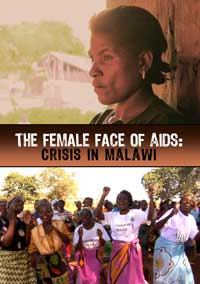By Sarah Boslaugh
February 6, 2009Â
Â
 Many Americans still think of AIDS as a disease of gay men, but this is a misconception: about half the adults infected with HIV worldwide are women and the usual route of infection reported is heterosexual sex. In Malawi, the subject of the documentary The Female Face of AIDS, the national rate of infection is estimated at 14%, with almost 60% of the infected being female. Â
Many Americans still think of AIDS as a disease of gay men, but this is a misconception: about half the adults infected with HIV worldwide are women and the usual route of infection reported is heterosexual sex. In Malawi, the subject of the documentary The Female Face of AIDS, the national rate of infection is estimated at 14%, with almost 60% of the infected being female. Â
In 2007, a team of four faculty members and eight students from the Leitner Center for International Law and Justice of the Fordham Law School traveled to Malawi to study why Malawian women are disproportionately infected with HIV and how HIV infection affects their lives. Interviews conducted by the team, which are recorded in the documentary, reveal a deadly combination of female inequality, poverty, and cultural practices and beliefs which promote the spread of HIV and severely impact the lives of infected women and their children.Â
Some of the factors which promote HIV+ transmission in Malawi are common to many countries of the world. First of all, Malawi is a poor country: the per capital income in 2006 was $690, and per capita government expenditure on health in 2005 was $64. Women do not have the right to assert themselves in sexual situations, for instance by insisting their husband use a condom. They also have few ways to earn a living, and if they are HIV+ are often abandoned by their husband (the most likely route of the woman’s infection, since multiple sexual partners are both common and socially acceptable for Malawian men but not for women) and shunned by their community. As a result, some infected women become prostitutes, further spreading HIV infection to men who will spread it to their wives. Â
The Fordham team also discovered some cultural practices specific to Malawi which further support HIV transmission. One is the custom of “widow cleansing†in which a widow is expected to have intercourse with a specific man (the “widow cleanserâ€) after her husband dies, in order to be accepted back into her community. Another is the practice of requiring girls to have intercourse with an appointed man as soon as they begin to menstruate, in order to be considered a woman. Not coincidentally, both practices deny women the right to control their own bodies or protect themselves from HIV infection. Â
Not all is bleak, however: antiretroviral therapy is available in Malawi, and some of the women and children interviewed are receiving it. Some of the women have also begun to take action to help other women: for instance a woman identified only as “Daphne†responded to learning of her infection (by her promiscuous husband, who refused to accept responsibility) by founding the Coalition of Women Living with HIV, the Malawi’s first HIV/AIDS organization run for and by women.
The Female Face of AIDS is a straightforward, high-quality film suitable for classroom use. Despite the serious subject matter (statistics presented at the end of the film highlight the serious consequences of HIV infection for Malawian women), the film itself is not downbeat: high production values, including excellent photography and a soundtrack of traditional African music, and the positive attitude of most interview subjects, emphasize the strength of Malawian women and the possibility of positive change. Â
The only DVD extras are a gallery of still photographs accompanied by traditional music, and a link to a guidebook for the film. The Female Face of AIDS is available from Choices, Inc: further information is available from www.choicesvideo.net or by calling 1-888-570-5400. Further information about the Leitner Center’s work in Malawi, including a copy of the report We Will Still Live: Confronting Stigma and Discrimination Against Women Living with HIV/AIDS in Malawi, is available from www.leitnercenter.org. Â
—– Â
The Female Face of AIDS: Crisis in Malawi
Choices, Inc.
Directed by Doug Karr and Edward Boyce
Color, 2008, 33 Minutes



